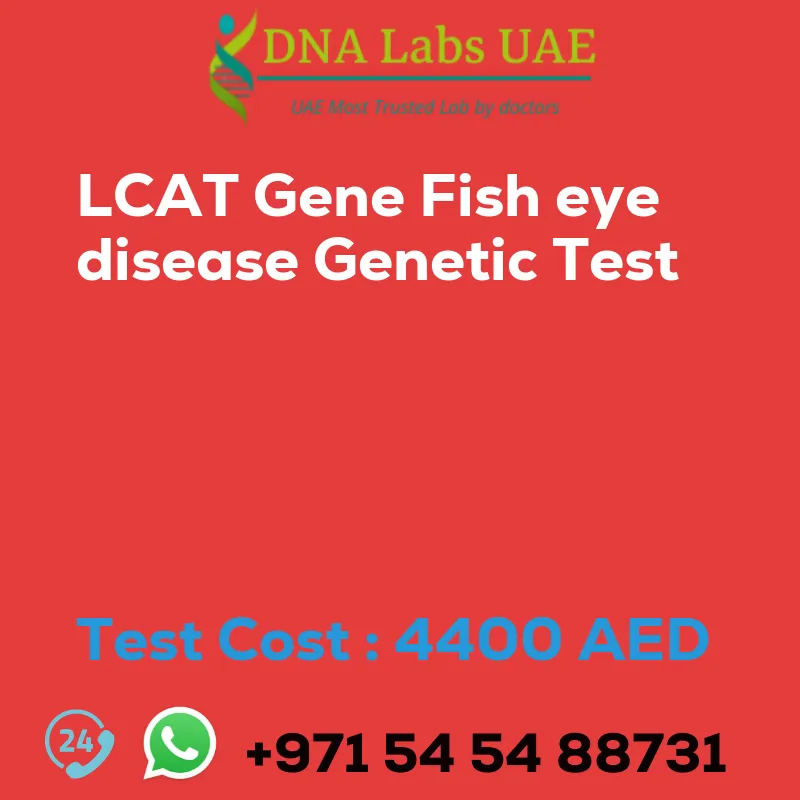LCAT Gene Fish Eye Disease Genetic Test
At DNA Labs UAE, we offer the LCAT Gene Fish Eye Disease Genetic Test to provide valuable insights into the underlying genetic cause of this rare disorder. This comprehensive test uses NGS (Next-Generation Sequencing) technology to analyze the LCAT gene and identify specific mutations associated with fish eye disease.
Test Components and Price
The LCAT Gene Fish Eye Disease Genetic Test is priced at 4400.0 AED. The test can be performed using either a blood sample, extracted DNA, or one drop of blood on an FTA Card.
Report Delivery
After the sample is collected, the report will be delivered within 3 to 4 weeks.
Test Method
The LCAT Gene Fish Eye Disease Genetic Test utilizes NGS technology, which allows for the simultaneous analysis of multiple genes. This provides a comprehensive view of an individual’s genetic makeup and enables the identification of specific mutations in the LCAT gene.
Test Type
The LCAT Gene Fish Eye Disease Genetic Test falls under the category of metabolic disorders.
Referring Doctor and Test Department
This test can be requested by a general physician and is conducted in our Genetics department.
Pre Test Information
Prior to the test, it is important to provide the clinical history of the patient who is undergoing the LCAT Gene Fish Eye Disease NGS Genetic DNA Test. Additionally, a genetic counseling session may be conducted to draw a pedigree chart of family members affected by fish eye disease.
Test Details
The LCAT gene is responsible for producing an enzyme called lecithin-cholesterol acyltransferase, which plays a crucial role in lipid metabolism and the breakdown of cholesterol. Fish eye disease is a rare genetic disorder caused by mutations in the LCAT gene. This leads to the accumulation of cholesterol and other lipids in various tissues, including the cornea, resulting in clouding and impaired vision.
NGS genetic testing allows healthcare professionals to analyze the LCAT gene and identify any mutations or variations that may be present. This information can help confirm a diagnosis of fish eye disease and provide important insights into the genetic cause of the condition.
In addition to diagnosis, NGS genetic testing can also be used for carrier screening. This allows individuals to determine if they carry a mutation in the LCAT gene that could be passed on to their children. Such information is crucial for family planning and making informed decisions about reproductive options.
Overall, NGS genetic testing for the LCAT gene in fish eye disease provides valuable information for diagnosis, prognosis, and genetic counseling. It empowers individuals and healthcare providers to make informed decisions regarding treatment options and management strategies.
| Test Name | LCAT Gene Fish eye disease Genetic Test |
|---|---|
| Components | |
| Price | 4400.0 AED |
| Sample Condition | Blood or Extracted DNA or One drop Blood on FTA Card |
| Report Delivery | 3 to 4 Weeks |
| Method | NGS Technology |
| Test type | Metabolic Disorders |
| Doctor | General Physician |
| Test Department: | Genetics |
| Pre Test Information | Clinical History of Patient who is going for LCAT Gene Fish eye disease NGS Genetic DNA Test A Genetic Counselling session to draw a pedigree chart of family members affected with Fish eye disease |
| Test Details |
The LCAT gene is responsible for providing instructions to produce an enzyme called lecithin-cholesterol acyltransferase. This enzyme plays a crucial role in lipid metabolism, specifically in the breakdown and removal of cholesterol from the body. Fish eye disease is a rare genetic disorder caused by mutations in the LCAT gene. It is characterized by the accumulation of cholesterol and other lipids in various tissues, including the cornea, causing clouding and impaired vision. NGS (Next-Generation Sequencing) genetic testing is a technique used to analyze multiple genes simultaneously, providing a comprehensive view of an individual’s genetic makeup. In the case of fish eye disease, NGS can be used to identify specific mutations in the LCAT gene that are associated with the disorder. By analyzing the LCAT gene using NGS, healthcare professionals can identify any mutations or variations that may be present. This information can help in confirming a diagnosis of fish eye disease and provide important insights into the underlying genetic cause of the condition. NGS genetic testing can also be used for carrier screening, allowing individuals to determine if they carry a mutation in the LCAT gene that could be passed on to their children. This information can be useful for family planning and making informed decisions about reproductive options. Overall, NGS genetic testing for the LCAT gene in fish eye disease can provide valuable information for diagnosis, prognosis, and genetic counseling. It can help individuals and their healthcare providers make informed decisions about treatment options and management strategies. |








